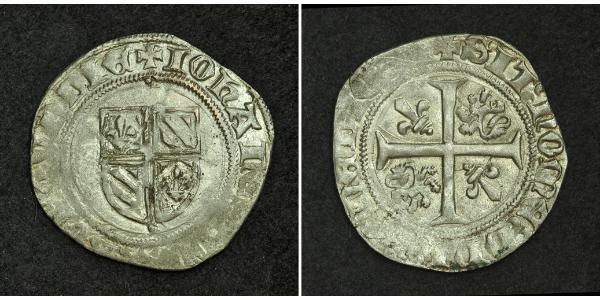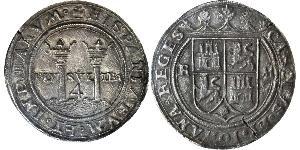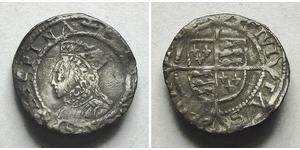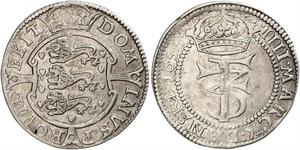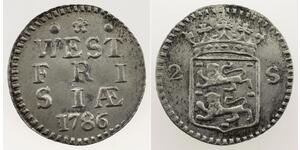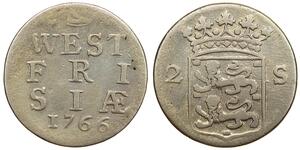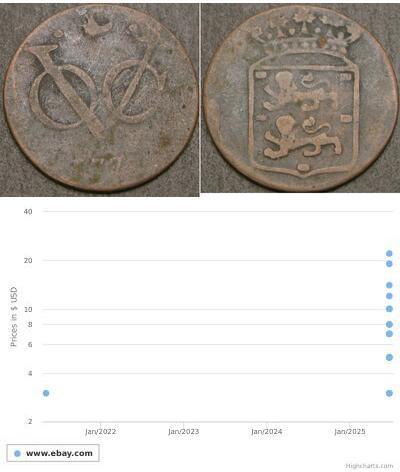(продана за $34.0)
1404, France, Burgundy (Duchy), John I "the Fearless". Silver Grand Blanc Coin. R!
Condition: VF-XF!
Mint Place: Auxonne?
Mint Year: 1404-1419
State: Burgundy (Duchy)
Denomination: blanc guénar (2nd Emission)
Reference: B. 1224, Dumas-Dubourg 14-8-1. R!
Diameter: 26mm
Material: Silver
Weight: 2.99gm
Obverse: Shield with coat-of-arms. Secret privy mark (pellet below cross in legend at 12 o'clock).
Legend: + IOhΛnЄS DVX BVRGVnDIЄ
Reverse: Cross pattée with lion rampant left and lis in opposite quarters.
Legend: + SIT nOmЄ DnI BЄnЄDICTV
The Duchy of Burgundy (Latin: Ducatus Burgundiae, French: Duché de Bourgogne, Dutch: Hertogdom Bourgondië) from 1032 existed as a successor of an ancient and prestigious patrimony and a large division of the lands of the Kingdom of the Burgundians. The duchy roughly conforms to the borders and territories of the modern region of Burgundy, but its dukes came to own considerable possession of numerous French and Imperial fiefs further north in the Low Countries collectively known as the Burgundian Netherlands. In its own right, it was one of the larger ducal territories that existed at the time of the emergence of Early Modern Europe from Medieval Europe, reminiscent of the Middle Frankish realm of Lotharingia.
The French remnants of the Burgundian kingdom were demoted to a ducal rank by King Robert II of France in 1004 and in 1032 awarded to the House of Burgundy as a cadet branch inheritance via Salic law – other portions had passed to the Imperial Kingdom of Arles and the Free County of Burgundy. From 1363 the duchy was ruled by a succession of the Valois Burgundy dukes. Their extinction with the death of Charles the Bold in the 1477 Battle of Nancy led to the absorption of the duchy itself into the French crown lands by King Louis XI, while the Burgundian possessions in the Low Countries passed to the Habsburg archduke Maximilian I of Austria by his marriage with Charles' daughter Mary the Rich.
Even in its diminished size as it existed in the Early Modern Period, the Burgundian heritage that was divided between two heirs played a pivotal role in Europe's politics long after it lost its role as an independent political identity, due to marriages and wars over the territories between princes who were related to its former rulers. With the abdication of the Habsburg emperor Charles V (Charles I as King of Spain) in 1556, the Burgundian Netherlands passed to the Spanish Empire of King Philip II. During the Dutch Revolt or Eighty Years War (1568–1648), the northern provinces of the Low Countries gained their independence from Spanish rule and formed the Dutch Republic (today the Netherlands), while the southern provinces remained under Spanish rule and were known as the Spanish Netherlands or Southern Netherlands (corresponding roughly to present day Belgium, Luxembourg, and the areas in France corresponding to the Nord department and part of the Pas-de-Calais department).
John the Fearless (French: Jean sans Peur, Dutch: Jan zonder Vrees), also John II, Duke of Burgundy, known as John of Valois and John of Burgundy (28 May 1371 – 10 September 1419), was Duke of Burgundy from 1404 to 1419. For a period he was regent for his mentally ill first cousin Charles VI of France and a member of the Valois Dynasty.
Born in Dijon, John was the son of Philip the Bold and Margaret III, Countess of Flanders. As heir apparent, he used the title of Count of Nevers from 1384 to 1405, however, after his accession he ceded it to his brother Philip.
In 1385, at the Burgundian double wedding in Cambrai, he married Margaret of Bavaria, daughter of Albrecht of Bavaria, Count of Holland and Hainaut at the same time his sister, Margaret of Burgundy, Duchess of Bavaria married their son William II, Duke of Bavaria, to consolidate his position in the Low Countries, after cancelling his engagement with Catherine of France, daughter of Charles V of France.
Before his accession to the Duchy of Burgundy, John was one of the principal leaders of the French forces sent to aid King Sigismund of Hungary in his war against Sultan Bayezid I. John fought in the battle of Nicopolis (25 September 1396) with such enthusiasm and bravery that he was given the nickname of Fearless (Sans-Peur). Despite his personal bravery, his impetuous leadership ended in disaster for the European expedition. He was taken prisoner and released only in the next year, against an enormous ransom paid by his father.
John was invested as Duke of Burgundy in 1404 and almost immediately entered into open conflict against Louis of Orléans, younger brother of the increasingly mad Charles VI. Both men attempted to fill the power vacuum left by the demented king.
John played a game of marriages, exchanging his daughter Marguerite for Michelle of Valois, who would marry his heir, Philip the Good. He did not overlook, however, the importance of the middle class of merchants and tradesman or the University of Paris.
Louis tried to gain the favour of Queen Isabeau, and may have become her lover. After a game of hide and seek in which his son-in-law, the Dauphin, was successively kidnapped and recovered by both parties, the Duke of Burgundy managed to gain appointment by royal decree – during one of the king's "absent" periods when mental illness manifested itself – as guardian of the Dauphin and the king's children. This did not improve the relations between John and Louis. Soon the two rivals descended into making open threats. Their uncle, John, Duke of Berry, secured a vow of solemn reconciliation, but three days later, on 23 November 1407 Louis was brutally assassinated in the streets of Paris. The order, no one doubted, had come from the Duke of Burgundy, who shortly admitted to the deed and declared it to be a justifiable act of "tyrannicide". According to Thomas Walsingham, Orléans had simply received his just deserts as he had been "taking his pleasure with whores, harlots, incest" and had committed adultery with the wife of an unnamed knight who had taken his revenge by killing him under the protection of the Duke of Burgundy. After an escape from Paris and a few skirmishes against the Orléans party, John managed to recover the king's favour. In the treaty of Chartres, signed on 9 March 1409, the king absolved the Duke of Burgundy of the crime, and he and Louis's son Charles pledged a reconciliation. A later edict renewed John's guardianship of the Dauphin.
Even with the Orléans dispute resolved in his favour, John would not have a simple life. Louis' son and heir, Charles was only 14 at the time of his father's death and was forced to depend heavily on his allies to support his claims for the property that had been confiscated from him by the Duke of Burgundy. Chief among these allies was his father-in-law Bernard VII, Count of Armagnac and because of this alliance their faction became known as the Armagnacs. With Peace solemnly sworn in 1410, John returned to Burgundy and Bernard remained in Paris where he reportedly shared the queen's bed. Armagnac's party was not content with political power, and after a series of riots and attacks against the citizens, John was recalled to the capital, then sent back to Burgundy in 1413. At this time King Henry V of England invaded French territory and threatened to attack Paris. During the peace negotiations with the Armagnacs, Henry was also in contact with John who was keen to wrest control of France away from Charles VI. Despite this he continued to be wary of forming an alliance with the English for fear of destroying his immense popularity with the common people of France. When Henry demanded Burgundy's support for his claim to be rightful King of France, John backed away and decided to ally himself with the Armagnacs. Although he talked of helping his sovereign, his troops took no part in the Battle of Agincourt (in 1415), although two of his brothers, Antoine, Duke of Brabant, and Philip II, Count of Nevers, died fighting for France during the battle.
Two years later, with the rivalry between Burgundians and Armagnacs at an all-time high because of the shattering defeat at Agincourt, John's troops set about the task of gaining Paris. On 30 May 1418, he captured the city, but not before the Dauphin (the traditional name of the heir apparent to the throne of France), the future Charles VII of France, had escaped. John then installed himself in the city and made himself protector of the King. Although not an open ally of the English, John did nothing to prevent the surrender of Rouen in 1419. With the whole of northern France in English hands and Paris occupied by Burgundy, the Dauphin tried to bring about a reconciliation with John. They met in July and swore peace on the bridge of Pouilly, near Melun. On the grounds that peace was not sufficiently assured by the Pouilly meeting, a fresh interview was proposed by the Dauphin to take place on 10 September 1419 on the bridge at Montereau. John of Burgundy was present with his escort for what he considered a diplomatic meeting. He was, however, assassinated by the Dauphin's companions. He was later buried in Dijon. His successor, Philip the Good, formed an alliance with the English.

|
Добавив:
anonymous 2015-04-03 |
2 Stuiver Нідерланди Срібло
в групі 33 монет / 33 цін
⇑

